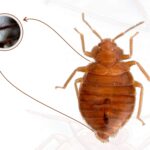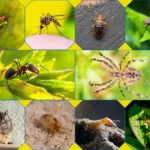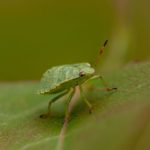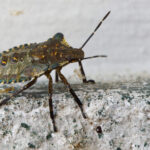Swallow bugs are ectoparasites that mostly infest birds, especially swallows, and their nests. They are often referred to as swallow bugs or swallow bug nymphs. They are closely related to bed bugs (Cimicidae), belonging to the same family. People often confuse bed bugs and swallow bugs. But the swallow bugs derive their names from the birds that ingest bugs. Because of their similar size and look, many individuals mistakenly believe they have a bed bug infestation when they see them.
Swallow bugs, particularly those that feed on nestling swallows, consume bird blood. Tiny parasites called swallow bugs live in the nests of swallows. By draining their blood and that of their offspring, they feed on them. Find out more about bugs on insectinsider.
Table of contents
Lifetime of a Swallow Bug
A female swallow bug lays around 30 eggs at a time. The lifespan of a swallow bug is around two to three years. Although their life depends on whether they have a host or not. Swallow bugs do not reproduce as quickly as other bugs. However, if they consistently locate a host to feed on, they can live for many years.

Where Do Swallow Bugs Live?
Even if they might not reside in your house, swallow bugs can nevertheless enter if there is a swallow nest close to it. They’ll hide under mattresses, closets, and even wardrobes once they’re inside the house. When swallow birds, who are swallow bugs’ main food supply, are absent, swallow bugs will bite people.
The insects hide in cracks, crevices, and other shelter places. You can see them around swallow nests as well. You can see them in the mud and feathers that they use to build their nests. In comparison to bed bugs, swallow bugs are less frequent and they infest only in the places around their populations.

How To Get Rid of Swallow Bugs?
Addressing the infestation at its source—often the swallow nests—is the key to getting rid of swallow bugs. We discuss some of the ways you can get rid of swallow bugs:

Remove Swallow Nests
Eliminate swallow nests from the impacted area if at all feasible. Do this before they nest to protect the birds. To stop swallows from constructing fresh nests in the same spot, close off entry points.
Clean and Sanitize
Make sure to thoroughly clean the contaminated area, taking note of any garbage, bird droppings, or nesting materials. Get rid of the materials the right way. To eradicate any lingering swallow bugs or eggs, cleanse the area with the proper cleaning supplies.
Apply Insecticides
Treat the afflicted areas with insecticides. It’s crucial to use environmentally safe chemicals and adhere to manufacturer guidelines. Pay close attention to any gaps, clefts, and other hiding spots where swallow bugs might be lurking.
Consult Pest Control Professionals
Seek advice from pest control experts if the infestation is severe or if you are unclear about the best course of action. Professionals can help address the infestation since they have the knowledge and access to efficient insecticides.
Implement Preventive Measures
Sealing off building and structure entry points will help prevent future infestations by reducing the opportunity for swallows to construct nests near residential areas.
Swallow Bugs vs. Bed Bugs
It’s hard to differentiate between swallow bugs and bed bugs. Both of these tiny, oval “bat bugs” have brown or gray bodies and require blood to procreate. However, swallow bugs have seasonal feeding, while bedbugs can obtain blood year-round. Swallow bugs are different from bed bugs in the following ways:
- You’ll notice swallow bugs closer to the ceiling since they reside in swallow nests.
- They don’t reproduce in your bed and have fine hair across their bodies.
- Swallow bugs have longer, equal-length segments at the terminals of their antennae.
- Mostly in the winter, after the swallows have moved south, they appear.
- While bedbugs can deposit up to five eggs every day, they can lay thirty eggs at once.
- A swallow bug egg takes closer to a month to hatch than a bedbug egg, which can hatch in approximately a week.
- Bedbugs usually survive one year, but swallow bugs might live two to three years.
- Swallow bugs are less common than bedbugs since they only emerge for food.
Do Swallow Bugs Bite Humans?
Humans are only bit by swallow bugs when there are no birds in the area. Since swallows migrate every year and these bugs can go a year without food, swallow bugs can survive for up to three years by “intermittent fasting,” during which they feed on human blood throughout the winter.
The bugs have the ability to enter human quarters as the birds migrate south. Your response will differ, and you won’t feel the bite. Bits do not affect some people. Some people may have a lump that resembles a mosquito bite, while others may experience an allergic reaction or rash.
Swallow insect saliva combines with your blood when feeding, causing this effect. Similar to a mosquito bite, this may result in irritating swellings on your skin that go away in a day or two. In addition to not causing diseases, swallow bugs don’t consume enough blood to be harmful.

When do Swallow Bugs Bite?
Swallow bugs will bite people with ease. Similar to bed bugs, bite frequency peaks during two distinct seasons of the year. One occurs in the spring, just before the overwintered swallow bugs start to work again and the migrating swallows return to nest on the building. Since the majority of survivors are adults and extremely hungry at this point, they might actively look for other sources of blood to eat. When swallows are around and swallow bugs go to the nest area, problems go away. Once again, residences will be more likely to have swallow bugs, and when the swallows leave the nest, there may be bites.
Swallow Bugs: Our Concluding Remarks
Even though swallows are fascinating and lovely to observe, an excessive number of swallow bugs unfortunately results in swallow bugs. The good news is that swallow bugs are not deadly, despite being a nuisance and probably making you squirm just thinking about them. Additionally, they are less prone to cause troublesome infestations than their relatives, bed bugs. However, it’s critical to take care of these pests as soon as you become aware of them. It might be time to call a licensed exterminator if you have attempted the above techniques we suggested and you are still having problems with swallows and the problems they cause.
Frequently Asked Questions (FAQs) about Swallow Bugs
Q1. What is a swallow bug?
Two insects related to bed bugs are swallow bugs and bat bugs. Swallow bugs grow on cliff swallows, while bat bugs grow on bats. If a building has the roosts or nesting places of their wild animal hosts, then you may find bat bugs and swallow bugs within the residence.
Q2. Is it bad if you swallow a bug?
It’s unlikely that swallowing common insects like spiders, gnats, mosquitoes, etc. will cause you any harm. According to Dr. Bobbi Pritt, MD, FCAP, a microbiologist, pathologist, and the director of the clinical parasitology laboratory at Mayo Clinic, your body breaks them down just like any other protein-rich food.
Q3. Do swallow bugs bite?
Once inside the house, they’ll take refuge in wardrobes and closets, mattresses, or even crevices on the floor. When swallow birds, who are swallow bugs’ main food supply, are absent, swallow bugs will bite people.
Q4. How big are swallow bugs?
Their length is approximately 3–4 mm, and you can distinguish them from bed bugs by their longer pronotal hairs (the hairs on a swallow bug’s head and neck, I believe, are longer than the width of its eye), longer body hairs, and equal length third and fourth antennal segments.
Q5. How do you treat swallow bugs?
If there is swallow bug activity within the building, a pest control expert will probably need to treat the area with a residual insecticide to get rid of the infestation. Since insecticides can occasionally be extremely hazardous to birds, it is best to avoid using them in regions where birds are still present.
Q6. What color is the swallow bug?
You can distinguish swallow bugs from other bugs by their antennae, the length of the last two segments is the same. In addition, the hue of this species tends to be grayish brown as opposed to the reddish brown of human bed bugs.










